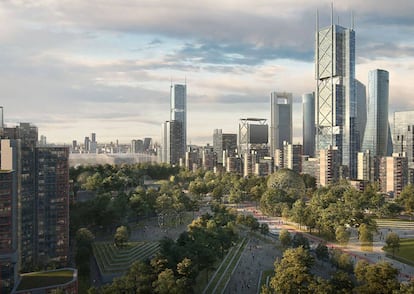After 25 years, Madrid’s Chamartín megaproject is about to get underway
The €7.3 billion plan will create over 240,000 jobs and revitalize the economy, says the new administration in the Spanish capital


After 25 years of political deadlock, a major real estate development project in Madrid is about to get greenlighted by the local council this coming Monday.
Madrid Nuevo Norte, formerly known as Operation Chamartín, is a €7.3 billion megaproject in the north of the capital involving 3.3 million square meters of land and nearly 10,500 new housing units, office space, business premises and green areas.
Supporters have called Madrid Nuevo Norte the biggest urban regeneration project in Europe
The plan also seeks to bring the Chamartín train station railyards underground, eliminating the physical barrier they now create between Plaza de Castilla and Avenida de Burgos. A large park covering 120,000 square meters will take their place.
The city is talking about an economic impact of nearly €18.3 billion in the region, and says that 241,700 new jobs will be created. Supporters have called Madrid Nuevo Norte the biggest urban regeneration project in Europe.
But it has also been a headache for successive administrations, most recently that of Manuela Carmena, whose team reshaped the old project into what it is today. Following municipal elections on May 26, control over the city has reverted to the Popular Party (PP), who is sharing power with Ciudadanos. (see side box)
Political agreement
The PP, Ciudadanos and Carmena’s Más Madrid have stated that they will vote in favor of the project on Monday, representing 45 seats on the council, far above the 29 required for an absolute majority. The Socialist Party (PSOE) and the far-right Vox have yet to adopt a position.
After that, final approval must be granted by the regional government, as the project involves changes to existing zoning legislation.
Neighborhood associations, environmental groups and other activists have flooded city hall with over 3,200 claims during the public review process. “This is basically a speculative operation, and from its genesis it has been subjected to the plans of the construction company San José and the BBVA bank,” says Quique Villalobos, president of FRAVM, a federation of neighborhood associations,
The group behind the project is the developer Distrito Castellana Norte (DCN), which is controlled by the BBVA (75.5%) and San José (24.5%)
José Manuel Calvo, a former urban planning official who worked on the megaproject, said on Wednesday that there are several basic changes to the previous draft. The first change turned a model based on private vehicle transit to one where 80% of trips will be made on public transportation.
This in turn meant placing private buildings – those with office space, stores and hotels – near the train station, rather than around the M-30 ring road as previous planned. And the amount of subsidized housing was raised from 10% -- the minimum required by law – to 20%.
Another quarter century
Construction work is scheduled to start in late 2020, and the entire project will take 24 years to complete. It will be built in several phases: Centro de Negocios (Business Center), Las Tablas Oeste, slated for completion in 2033, and Malmea-San Roque-Tres Olivos, due to be finished in 2037.
Over 60% of the space is reserved for service-based activities such as offices, stores, hotels and restaurants, compared with 35.46% for housing. A further 1.3 million square meters will be used to develop public transportation, green areas and street furniture.
English version by Susana Urra.
Tu suscripción se está usando en otro dispositivo
¿Quieres añadir otro usuario a tu suscripción?
Si continúas leyendo en este dispositivo, no se podrá leer en el otro.
FlechaTu suscripción se está usando en otro dispositivo y solo puedes acceder a EL PAÍS desde un dispositivo a la vez.
Si quieres compartir tu cuenta, cambia tu suscripción a la modalidad Premium, así podrás añadir otro usuario. Cada uno accederá con su propia cuenta de email, lo que os permitirá personalizar vuestra experiencia en EL PAÍS.
¿Tienes una suscripción de empresa? Accede aquí para contratar más cuentas.
En el caso de no saber quién está usando tu cuenta, te recomendamos cambiar tu contraseña aquí.
Si decides continuar compartiendo tu cuenta, este mensaje se mostrará en tu dispositivo y en el de la otra persona que está usando tu cuenta de forma indefinida, afectando a tu experiencia de lectura. Puedes consultar aquí los términos y condiciones de la suscripción digital.
More information
Archived In
Últimas noticias
The complicated life of Francesca Albanese: A rising figure in Italy but barred from every bank by Trump’s sanctions
Reinhard Genzel, Nobel laureate in physics: ‘One-minute videos will never give you the truth’
Pinochet’s victims grapple with José Antonio Kast’s rise in Chile
How Japan is trying to avert ‘digital defeat’
Most viewed
- Pablo Escobar’s hippos: A serious environmental problem, 40 years on
- Reinhard Genzel, Nobel laureate in physics: ‘One-minute videos will never give you the truth’
- Why we lost the habit of sleeping in two segments and how that changed our sense of time
- Charles Dubouloz, mountaineering star, retires at 36 with a farewell tour inspired by Walter Bonatti
- The Florida Keys tourist paradise is besieged by immigration agents: ‘We’ve never seen anything like this’










































